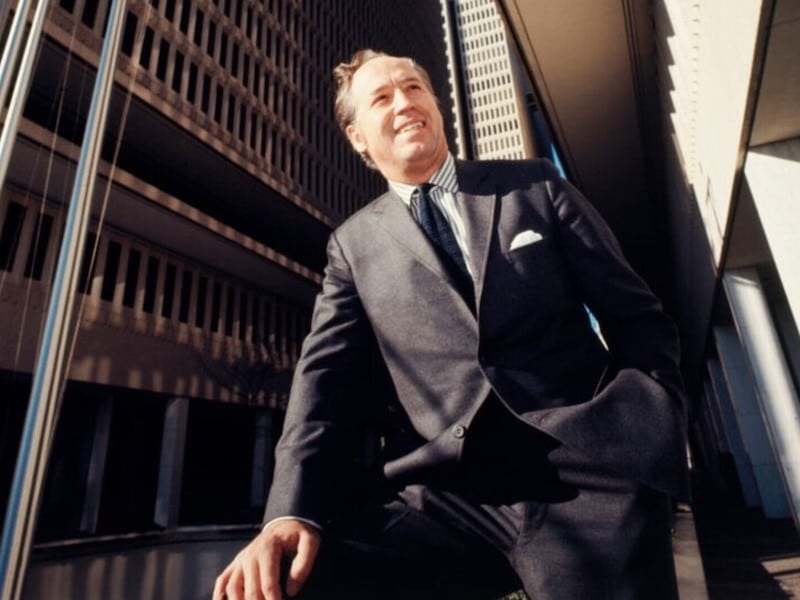Look Inside: Top 10 Detroit Interiors
Step inside to view some of Detroit’s most captivating architecture — exotic movie houses with Burmese, Hindu, Persian, Indian and Chinese motifs; cathedral-like Art Deco masterpieces; and museums with rich, symbollic designs.
The AIA-Detroit’s Urban Priorities Committee is back with its list of the city’s 10 best interiors. The group, whose members include prominent architects, planners, educators, designers, construction managers and journalists, reviews, critiques and generates projects for metro Detroit. Here’s a peek inside their favorite buildings around the city, with their own comments and using their “AIA Guide to Detroit Architecture” as a reference.
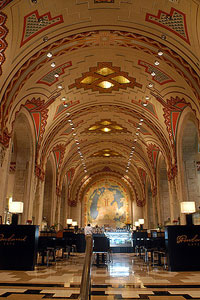 1. Guardian Building (500 Griswold)
1. Guardian Building (500 Griswold)
Wirt Rowland (Smith, Hinchman & Grylls)
1929
The interior areas of this Art Deco masterpiece are as breathtaking as the exterior — especially the cathedral-like, opulent lobby and banking room, with their opaque stained glass windows, Rockwood tiles, grand metal archway, Tiffany clock and mural depicting the state of Michigan. It is no wonder the building was once referred to as the “cathedral of finance.” You can now enjoy the view of the vaulted ceilings while sipping a cappuccino at the new Rowland Café, named for the building’s architect. The architecture firm that designed the building for the Union Trust Bank nearly 75 years ago is now the 40-floor building’s lead tenant (today known simply as SmithGroup).
2. Fox Theater/Lobby (2111 Woodward)
C. Howard Crane
1928
With the Roaring Twenties hurtling along, architecture burst the bounds of traditional Renaissance forms. The movie palace proved most receptive to exotic, if not wild, experimentation. C. Howard Crane, designer of some 250 theaters around the nation, created in the Fox a picturesque blend of Burmese, Hindu, Persian, Indian, and Chinese motifs. Not a little of this flamboyance seeps to the exterior of the more restrained 10-story office building, which sports an Art Deco façade.
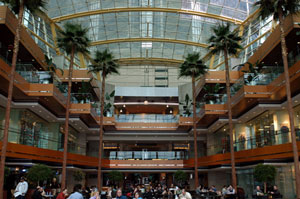 3. GM Wintergarden/Center Core Lobby (500 E. Jefferson)
3. GM Wintergarden/Center Core Lobby (500 E. Jefferson)
John Portman and Associates, 1977; Skidmore, Owings & Merrill
2000
The five-story Wintergarden, which sweeps out to the new riverfront promenade, invites visitors into its clean open space. General Motors’ courage and SOM’s design editing clarified, adjusted and expanded the original confusing Portman design. The interior circulation ring – with 288 suspended glass panels — adds to the spatial thrill.
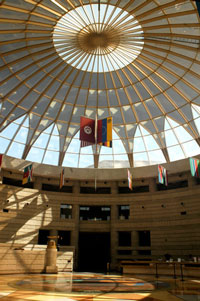 4. Charles H. Wright Museum of African American History (315 E. Warren)
4. Charles H. Wright Museum of African American History (315 E. Warren)
Sims-Varner
1998
This museum is replete with symbolic references to African art and architecture. For example, the column form is based on a traditional African rope motif. The central hall is layered in meaning, as well. Richard Bennett’s African masks and bronze doors are impressive. Sims-Varner created an inventively rich, must-see addition to Detroit’s Cultural Center.
 5. McGregor Memorial Conference Center (495 Ferry Maill)
5. McGregor Memorial Conference Center (495 Ferry Maill)
Minoru Yamasaki and Associates
1958
This is one of Yamasaki’s masterpieces and believed by many to be among Detroit’s finest buildings. The two-story, nearly symmetrical pavilion is sheathed in warm travertine marble. An integral sunken garden and reflecting pool nestle behind the building’s podium, which is faced in Mankato stone. On the interior, two levels of conference rooms are arranged to either side of a sky-lighted entry hall and lounge, which has the feel of a modern gothic cathedral in miniature. A triangular geometric motif forms a decorative pattern throughout the building, from window shape to balcony rail and door detail. Inside and out, Yamasaki’s serenely luxurious material palette and composition recall Asian models of architecture and landscape design. 6. Kresge and Rivera Court – The Detroit Institute of Arts (5200 Woodward)
6. Kresge and Rivera Court – The Detroit Institute of Arts (5200 Woodward)
Paul P. Cret (many additions and renovations by others)
1927
The DIA ranks as one of Detroit’s cultural jewels and an indisputable architectural landmark. Its art collection is world class, and the white marble magnificence of Paul Cret’s Renaissance-inspired building has stood as a Detroit cultural touchstone for three-quarters of a century. Ironically, the most recognizable work at the DIA, Mexican artist Diego Rivera’s famous fresco murals of Ford’s Rouge factory and other industrial scenes, was installed over Cret’s objections. The architect felt that Rivera’s work defaced his building. He appealed to Albert Kahn, who served as adviser to the DIA board, but Kahn sided with Rivera. The artist considered it one of his most successful works.
 7. Fisher Building Lobby/Theatre (3011 W. Grand Boulevard)
7. Fisher Building Lobby/Theatre (3011 W. Grand Boulevard)
Albert Kahn
1929
As in any high Art Deco design, multiple stylistic references are brought together under the watchful eye of a master. The Fisher Building’s opulent interior features a three-story vaulted arcade finished with 40 varieties of marble, solid bronze trim and ornamentation extolling the virtues of commerce, industry, and the arts. Cranbrook artists assisted an army of itinerant European artisans to create a stunning work of old and new world design. Kahn’s observation that “architecture is ninety percent business and ten percent art” was inverted here — thanks in no small part to the Fisher brothers’ largesse.
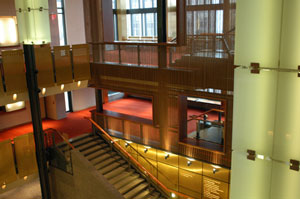 8. The Max/Orchestra Hall (3711 Woodward)
8. The Max/Orchestra Hall (3711 Woodward)
C. Howard Crane (numerous additions and renovations by others)
1919
This is one of C. Howard Crane’s early works in an impressive career as one of America’s premier theater designers. If the boxy exterior and neoclassical cloak seem a bit expeditious, perhaps it’s because the building was designed and built in six months. This feat was forced by conductor Ossip Gabrilovich’s threat of departure for want of a proper concert hall. The maestro got his wish, as Orchestra Hall is an acoustic and decorative marvel. The new four-story atrium lobby (Diamond and Schmitt Architects, 2003) has glass and mahogany finishes. The floor is made of Silverwater limestone from Manitoulin Island in northern Ontario. The Atrium offers three floors of reception and strolling space and can seat 350, banquet style. The Woodward Windows, on the second and third levels, have floor to ceiling views of Woodward.
9. The Redford Theatre (17360 Lahser)
Verner, Wilhelm and Molby
1928
This 1928 Detroit neighborhood movie house on the West Side was built to resemble a Japanese outdoor garden theater. Billed as “America’s Most Unique Suburban Playhouse,” the theater, with its three-story grand foyer and full-size stage, has been in continuous operation ever since it’s opening. The Japanese motif and design details were not spared, including appropriate decorations on the organ console.
 10. Compuware Atrium (One Campus Martius)
10. Compuware Atrium (One Campus Martius)
Rossetti & Associates
2003
Inside the main entrance is an atrium that spans the height of the entire 15-story building. The spaciousness and openness provide the feeling of still being outdoors. A fountain composed of hanging, bright translucent materials suspended from the ceiling adds to this sense. The water cascades off these elements before pouring down a glass wall onto a black-stepped fountain at the building’s floor. Bamboo trees stand tall alongside one wall.
All photographs copyright Dave Krieger
